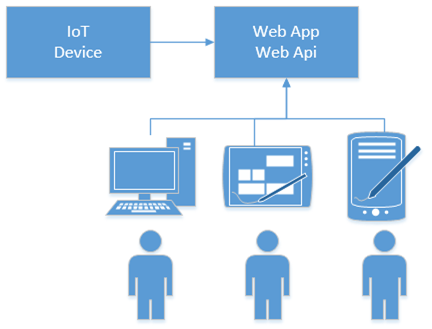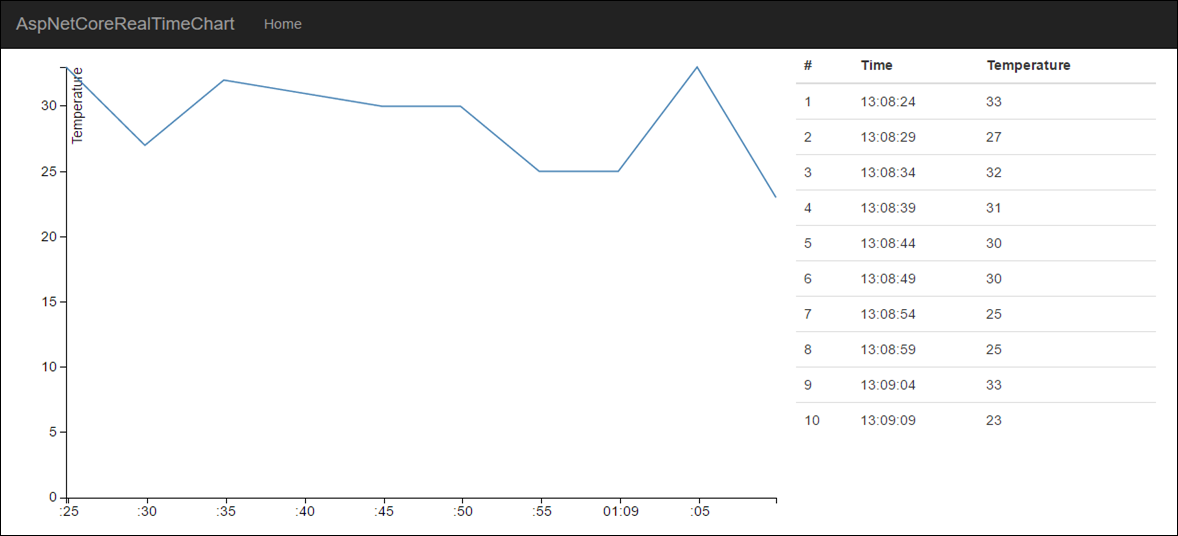Real-time chart using ASP.NET Core and WebSocket
Solution in glance
The following diagram illustrates our solution where IoT device reports readings to web site and users can see readings in real time.

There is IoT device that reports sensors readings to ASP.NET Core application. Users open the site in their browsers and they will see readings in real-time. Readings are shown as table and visualized as a line chart.
NB! Those who are interested in playing with Visual Studio 2017 solution and source code can find it from AspNetCoreRealTimeChart Github repository.
Adding WebSocket support
First we go and visit Radu Matei’s blog and take some code from there. Of course, we give him cookie and credits for his excellent writing Creating a WebSockets middleware for ASP .NET Core. We use a little modified version of his WebSocketManager class.
public class TemperatureSocketManager
{
private static ConcurrentDictionary<string, WebSocket> _sockets = new ConcurrentDictionary<string, WebSocket>(); public WebSocket GetSocketById(string id)
{
return _sockets.FirstOrDefault(p => p.Key == id).Value;
} public ConcurrentDictionary<string, WebSocket> GetAll()
{
return _sockets;
} public string GetId(WebSocket socket)
{
return _sockets.FirstOrDefault(p => p.Value == socket).Key;
}
public string AddSocket(WebSocket socket)
{
var id = CreateConnectionId();
_sockets.TryAdd(CreateConnectionId(), socket); return id;
} public async Task RemoveSocket(string id)
{
WebSocket socket;
_sockets.TryRemove(id, out socket); await socket.CloseAsync(closeStatus: WebSocketCloseStatus.NormalClosure,
statusDescription: "Closed by the WebSocketManager",
cancellationToken: CancellationToken.None);
} private string CreateConnectionId()
{
return Guid.NewGuid().ToString();
} public async Task SendMessageToAllAsync(string message)
{
foreach (var pair in _sockets)
{
if (pair.Value.State == WebSocketState.Open)
await SendMessageAsync(pair.Value, message);
}
} private async Task SendMessageAsync(WebSocket socket, string message)
{
if (socket.State != WebSocketState.Open)
return; await socket.SendAsync(buffer: new ArraySegment<byte>(array: Encoding.ASCII.GetBytes(message),
offset: 0,
count: message.Length),
messageType: WebSocketMessageType.Text,
endOfMessage: true,
cancellationToken: CancellationToken.None);
}
}
We also need WebSocket middleware to keep internal sockets dictionary fresh. Here we will use a little modified version of Radu Matei’s WebSocket middleware.
public class TemperatureSocketMiddleware
{
private readonly RequestDelegate _next;
private readonly TemperatureSocketManager _socketManager; public TemperatureSocketMiddleware(RequestDelegate next,
TemperatureSocketManager socketManager)
{
_next = next;
_socketManager = socketManager;
} public async Task Invoke(HttpContext context)
{
if (!context.WebSockets.IsWebSocketRequest)
{
await _next.Invoke(context);
return;
} var socket = await context.WebSockets.AcceptWebSocketAsync();
var id = _socketManager.AddSocket(socket); await Receive(socket, async (result, buffer) =>
{
if (result.MessageType == WebSocketMessageType.Close)
{
await _socketManager.RemoveSocket(id);
return;
}
});
} private async Task Receive(WebSocket socket, Action<WebSocketReceiveResult, byte[]> handleMessage)
{
var buffer = new byte[1024 * 4]; while (socket.State == WebSocketState.Open)
{
var result = await socket.ReceiveAsync(buffer: new ArraySegment<byte>(buffer),
cancellationToken: CancellationToken.None); handleMessage(result, buffer);
}
}
}
Now let’s add reference to Microsoft.AspNetCore.WebSockets NuGet package and wire WebSocket stuff to application. We use Configure() method of Startup class for this.
app.UseStaticFiles();
app.UseWebSockets();
app.UseMiddleware<TemperatureSocketMiddleware>(); app.UseMvc(routes =>
{
routes.MapRoute(
name: "default",
template: "{controller=Home}/{action=Index}/{id?}");
});
We have to register also WebSocket manager as a service to be able to broadcast data to browsers. Here is the ConfigureServices() method of application Startup class.
public void ConfigureServices(IServiceCollection services)
{
services.AddMvc();
services.AddSingleton<TemperatureSocketManager>();
}
Now we have everything we need to support WebSockets in out application.
Web API for IoT device
We need some web end-point where IoT device can send sensor readings.
public class ApiController : Controller
{
private readonly TemperatureSocketManager _socketManager; public ApiController(TemperatureSocketManager socketManager)
{
_socketManager = socketManager;
} public async Task Report(double liquidTemp)
{
var reading = new
{
Date = DateTime.Now,
LiquidTemp = liquidTemp
}; await _socketManager.SendMessageToAllAsync(JsonConvert.SerializeObject(reading));
} public async Task Generate()
{
var rnd = new Random(); for(var i = 0; i < 100; i++)
{
await Report(rnd.Next(23, 35));
await Task.Delay(5000);
}
}
}
Report() method accepts one sensor reading per time and broadcasts it to all registered sockets. Generate() method is there to simulate sensor that reports data. We can use this method if we don’t have any IoT device in our network.
Building user interface
Let’s build user interface for our solution to display real-time data to users. We start with simple home controller that just servers some views with no additional work.
public class HomeController : Controller
{
public IActionResult Index()
{
return View();
} public IActionResult Error()
{
return View();
}
}
Home view of Index controller is also simple. There are references to some D3 chart and Knockout related scripts. We will come back to these later. The view has placeholder for D3 chart. There is also table where sensor readings are displayed.
@{
ViewData["Title"] = "Home Page";
}
<div class="row">
<div class="col-lg-8 bigChart" data-bind="lineChart: lineChartData"></div>
<div class="col-lg-4">
<table class="table">
<thead>
<tr>
<th>#</th>
<th>Time</th>
<th>Temperature</th>
</tr>
</thead>
<tbody data-bind="foreach: lineChartData">
<tr>
<td data-bind="text: $index() + 1"></td>
<td data-bind="text: Date.toLocaleTimeString()"></td>
<td data-bind="text: LiquidTemp"></td>
</tr>
</tbody>
</table>
</div>
</div>
@section Scripts {
<script src="~/js/data-view-model.js"></script>
<script src="~/js/line-chart-binding.js"></script>
<script>
var D3KD = this.D3KD || {};
(function () {
"use strict";
var dataViewModel = new D3KD.dataViewModel();
var protocol = location.protocol === "https:" ? "wss:" : "ws:";
var wsUri = protocol + "//" + window.location.host;
var socket = new WebSocket(wsUri);
socket.onmessage = function (e) {
var reading = JSON.parse(e.data);
reading.Date = new Date(reading.Date);
dataViewModel.addDataPoint(reading);
};
ko.applyBindings(dataViewModel);
}());
</script>
}
When page is loaded then WebSocket connection is established and script starts listening to WebSocket. When data comes in the script sets Date property to JavaScript date and adds reading to Knockout array of data model.
Before wiring everything together let’s also modify layout view. I removed environment based mess from layout view and made popular scripts to be downloaded from CDN-s.
<!DOCTYPE html>
<html>
<head>
<meta charset="utf-8" />
<meta name="viewport" content="width=device-width, initial-scale=1.0" />
<title>@ViewData["Title"] - AspNetCoreRealTimeChart</title> <link rel="stylesheet" href="https://ajax.aspnetcdn.com/ajax/bootstrap/3.3.7/css/bootstrap.min.css" />
<link rel="stylesheet" href="~/css/site.css" asp-append-version="true" />
</head>
<body>
<nav class="navbar navbar-inverse navbar-fixed-top">
<div class="container">
<div class="navbar-header">
<button type="button" class="navbar-toggle" data-toggle="collapse" data-target=".navbar-collapse">
<span class="sr-only">Toggle navigation</span>
<span class="icon-bar"></span>
<span class="icon-bar"></span>
<span class="icon-bar"></span>
</button>
<a asp-area="" asp-controller="Home" asp-action="Index" class="navbar-brand">AspNetCoreRealTimeChart</a>
</div>
<div class="navbar-collapse collapse">
<ul class="nav navbar-nav">
<li><a asp-area="" asp-controller="Home" asp-action="Index">Home</a></li>
</ul>
</div>
</div>
</nav>
<div class="container body-content">
@RenderBody()
<hr />
<footer>
<p>© 2017 - AspNetCoreRealTimeChart</p>
</footer>
</div> <script src="https://ajax.aspnetcdn.com/ajax/jquery/jquery-2.2.0.min.js"></script>
<script src="https://ajax.aspnetcdn.com/ajax/bootstrap/3.3.7/bootstrap.min.js"></script>
<script src="http://d3js.org/d3.v3.min.js"></script>
<script src="http://knockoutjs.com/downloads/knockout-3.0.0.js"></script>
@RenderSection("Scripts", required: false)
</body>
</html>
With visible part of user interface we are done now and it’s time to stitch all parts together.
Displaying real-time data
As we are using D3 chart and Knockout to display real-time data we need some classes to bind these two together. I found d3-knockout-demo by Teodor Elstad where this problem is solved. It’s simple demo you can download to your machine and run it directly from directory. It doesn’t need any external data services to work. We start with data model class that is simplified to minimum.The code below goes to data-view-model.js file (see Index view of home controller).
/*global ko, setInterval*/
var D3KD = this.D3KD || {};
(function (namespace) {
"use strict";
namespace.dataViewModel = function () {
var self = this;
self.lineChartData = ko.observableArray();
self.addDataPoint = function (point) {
if (self.lineChartData().length >= 10) {
self.lineChartData.shift();
}
self.lineChartData.push(point);
};
};
}(D3KD));
The data model class holds Knockout observable array with readings. It also has addDataPoint() method that adds new reading to array. It aslo avoids array to grow over 10 elements. If array already has 10 readings then first reading is removed before new one is added.
To keep chart up to date we need Knockout bindingHandler. This comes also from Teodor’s demo project and it goes to line-chart-binding.js file (see Index view of home controller).
/*global ko, d3*/
ko.bindingHandlers.lineChart = {
init: function (element) {
"use strict";
var margin = { top: 20, right: 20, bottom: 30, left: 50 },
elementWidth = parseInt(d3.select(element).style("width"), 10),
elementHeight = parseInt(d3.select(element).style("height"), 10),
width = elementWidth - margin.left - margin.right,
height = elementHeight - margin.top - margin.bottom,
svg = d3.select(element).append("svg")
.attr("width", width + margin.left + margin.right)
.attr("height", height + margin.top + margin.bottom)
.append("g")
.attr("transform", "translate(" + margin.left + "," + margin.top + ")");
svg.append("g")
.attr("class", "x axis")
.attr("transform", "translate(0," + height + ")");
svg.append("g")
.attr("class", "y axis")
.append("text")
.attr("transform", "rotate(-90)")
.attr("y", 6)
.attr("dy", ".71em")
.style("text-anchor", "end")
.text("Temperature");
svg.append("path")
.attr("class", "line data");
},
update: function (element, valueAccessor) {
"use strict";
var margin = { top: 20, right: 20, bottom: 30, left: 50 },
elementWidth = parseInt(d3.select(element).style("width"), 10),
elementHeight = parseInt(d3.select(element).style("height"), 10),
width = elementWidth - margin.left - margin.right,
height = elementHeight - margin.top - margin.bottom,
// set the time it takes for the animation to take.
animationDuration = 750,
x = d3.time.scale()
.range([0, width]),
y = d3.scale.linear()
.range([height, 0]),
xAxis = d3.svg.axis()
.scale(x)
.orient("bottom"),
yAxis = d3.svg.axis()
.scale(y)
.orient("left"),
// define the graph line
line = d3.svg.line()
.x(function (d) { return x(d.Date); })
.y(function (d) { return y(d.LiquidTemp); }),
svg = d3.select(element).select("svg g"),
// parse data from the data-view-model
data = ko.unwrap(valueAccessor());
// define the domain of the graph. max and min of the dimensions
x.domain(d3.extent(data, function (d) { return d.Date; }));
y.domain([0, d3.max(data, function (d) { return d.LiquidTemp; })]);
svg.select("g.x.axis")
.transition()
.duration(animationDuration)
.call(xAxis);
svg.select("g.y.axis")
.transition()
.duration(animationDuration)
.call(yAxis);
// add the line to the canvas
svg.select("path.line.data")
.datum(data)
.transition()
.duration(animationDuration)
.attr("d", line);
}
};
No we have all ends connected and it’s time to see the web applicaton in action.
Real-time sensor data in action
To illustrate the end result better I added here screenshot and video. Video demonstrates how call to /api/Generate broadcasts new reading to all registered sensors after every five seconds.

Screenshot of real-time sensor data.
Real-time chart using ASP.NET Core and WebSocket的更多相关文章
- ASP.NET Core 集成 WebSocket
1. 环境 AspNetCore Web 2.0 (MVC) Windows 10 IIS 10 Express/IIS VS 2017 2.如何配置 在已有的或者新创建的 AspNet Core M ...
- 在Asp.net core中使用WebScocket
今天小试了一下在Asp.net core中使用websocket,这里记录一下: 在 Startup 类的 Configure 方法中添加 WebSocket 中间件. app.UseWebSocke ...
- ASP.NET Core 中的 WebSocket 支持(转自MSDN)
本文介绍 ASP.NET Core 中 WebSocket 的入门方法. WebSocket (RFC 6455) 是一个协议,支持通过 TCP 连接建立持久的双向信道. 它用于从快速实时通信中获益的 ...
- 关于ASP.NET Core WebSocket实现集群的思考
前言 提到WebSocket相信大家都听说过,它的初衷是为了解决客户端浏览器与服务端进行双向通信,是在单个TCP连接上进行全双工通讯的协议.在没有WebSocket之前只能通过浏览器到服务端的请求应答 ...
- .NET Core 基于Websocket的在线聊天室
什么是Websocket 我们在传统的客户端程序要实现实时双工通讯第一想到的技术就是socket通讯,但是在web体系是用不了socket通讯技术的,因为http被设计成无状态,每次跟服务器通讯完成后 ...
- ASP.NET Core MVC TagHelper实践HighchartsNET快速图表控件-开源
ASP.NET Core MVC TagHelper最佳实践HighchartsNET快速图表控件支持ASP.NET Core. 曾经在WebForms上写过 HighchartsNET快速图表控件- ...
- Displaying Data in a Chart with ASP.NET Web Pages (Razor)
This article explains how to use a chart to display data in an ASP.NET Web Pages (Razor) website by ...
- [翻译] 使用ElasticSearch,Kibana,ASP.NET Core和Docker可视化数据
原文地址:http://www.dotnetcurry.com/aspnet/1354/elastic-search-kibana-in-docker-dotnet-core-app 想要轻松地通过许 ...
- 如何使用vs将asp.net core项目添加容器支持并发布docker镜像到私有dockerhub和添加k8s/helm管理
这篇文章介绍一下,如何使用VS2017给asp.net core添加容器支持,并发布镜像到私有docker hub,然后用chart管理容器镜像的操作流程. 话不多说,just do it. 新建项目 ...
随机推荐
- 如何备份和恢复你的TFS服务器(一)
备份和恢复一个TFS(Team Foundation Server)服务器常常令人心生畏惧.因为这会涉及到很多服务和步骤.TFS(Team Foundation Server)2010一发布,我就知道 ...
- Python3 tkinter基础 Checkbutton variable 多选钮是否被选中
Python : 3.7.0 OS : Ubuntu 18.04.1 LTS IDE : PyCharm 2018.2.4 Conda ...
- 【C#复习总结】细说表达式树
1 前言 系类1:细说委托 系类2:细说匿名方法 系列3:细说Lambda表达式 系列4:细说泛型委托 系列5:细说表达式树 系列6:细说事件 涛声依旧,再续前言,接着用大佬的文章作为开头. 表达式树 ...
- Item 21: 比起直接使用new优先使用std::make_unique和std::make_shared
本文翻译自modern effective C++,由于水平有限,故无法保证翻译完全正确,欢迎指出错误.谢谢! 博客已经迁移到这里啦 让我们先从std::make_unique和std::make_s ...
- python3 pip 安装Scrapy在win10 安装报错error: Microsoft Visual C++ 14.0 is required. Get it with "Microsoft Visual C++ Build Tools": http://landinghub.visualstudio.com/visual-cpp-build-tools
问题描述 当前环境win10,python_3.6.1,64位. 在windows下,在dos中运行pip install Scrapy报错: building 'twisted.test.raise ...
- C. Polycarp Restores Permutation
链接 [https://codeforces.com/contest/1141/problem/C] 题意 qi=pi+1−pi.给你qi让你恢复pi 每个pi都不一样 分析 就是数学吧 a1 +(a ...
- hibernate设置二级缓存时报错java.lang.NoClassDefFoundError: org/hibernate/engine/jndi/JndiNameException
错误提示大概意思是,没有类定义错误,就是找不到要使用的hibernate二级缓存管理引擎类.我在这用的是ehcache二级轻量级缓存,报错原因可能是导入的jar包版本和使用的hibernate框架核心 ...
- rbac权限+中间件
1.权限组件rbac 1.什么是权限 1 项目与应用 2 什么是权限? 一个包含正则表达式url就是一个权限 who what how ---------->True or Flase 2.版本 ...
- 学习bootstrap3
官方手册(英文):http://getbootstrap.com/docs/3.3/getting-started/ 中文文档:https://v3.bootcss.com/getting-start ...
- No enclosing instance of type is accessible. Must qualify the allocation with an enclosing instance of type LeadRestControllerTest (e.g. x.new A() where x is an instance of ).
java - No enclosing instance is accessible. Must qualify the allocation with an enclosing instance o ...
